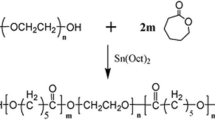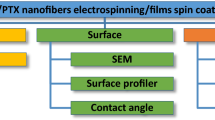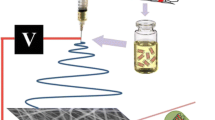Abstract
In the present study, a drug-delivery system based on electrospun nanofiber was developed. Polyamide (PA) as a fibers matrix was employed for the delivery of the anticancer drug doxorubicin (DOX). The nanofiber (NFs) was initially modified by incorporating β-cyclodextrin (β-CD) to generate an inclusion complex of β-CD and drug. The modified nanofiber was subsequently fabricated via an electrospinning approach of DOX/β-CD-incorporated PA. For understanding the role of β-CD in the inclusion of DOX, a DOX-incorporated nanofiber (i.e., PA/β-CD) was fabricated for comparison. β-CD enhanced the loading of DOX into PA NFs, resulting in an increased loading efficiency of 56% (PA/β-CD/DOX), compared to 47% for PA/DOX. In addition, the release profile of DOX and the effect of β-CD on the release behavior were investigated. The results demonstrated a substantial release of the drug (total release = ~ 92%) from PA/β-CD/DOX NFs, with a slower release rate (within 4 days) compared to PA/DOX without β-CD (total release = ~ 77%). Consequently, β-CD played a significant role in the sustained release of the drug. The viability of prostate cancer and LNCap cells in response to the drug was assessed for the NFs. The decreased cell viability observed in PA/β-CD/DOX indicates a sustained and controlled release behavior for this drug carrier system.
Graphical abstract









Similar content being viewed by others
References
Li D, Chen Y, Zhang Z, Chen M (2018) Mesoporous nanofibers mediated targeted anti-cancer drug delivery. MRS Adv 425:2991–3002
Aberoumandi SM, Mohammadhosseini M, Abasi E, Saghati S, Nikzamir N, Akbarzadeh A, Panahi Y, Davaran S (2017) An update on applications of nanostructured drug delivery systems in cancer therapy: a review. Nanomed Biotechnol 45:1058–1068
Deshmukh S, Kathiresan M, Kulandainathan MA (2022) A review on biopolymer-derived electrospun nanofibers for biomedical and antiviral applications. Biomater Sci 10:4424–4442
Balaji A, Vellayappan MV, John AA, Subramanian AP, Jaganathan SK, Supriyanto E, Razak SIA (2015) An insight on electrospun-nanofibers-inspired modern drug delivery system in the treatment of deadly cancers. RSC Adv 5:57984–58004
Hussain T, Ramakrishna S, Abid S (2022) Nanofibrous drug delivery systems for breast cancer: a review. Nanotechnology 33:102001
Ding Y, Li W, Zhang F, Liu Z, Zanjanizadeh Ezazi N, Liu D, Santos HA (2019) Electrospun fibrous architectures for drug delivery, tissue, engineering and cancer therapy. Adv Funct Mater 29:1802852
John JV, McCarthy A, Karan A, Xie J (2022) Electrospun nanofibers for wound management. ChemNanoMat 8:e202100349
Gao Y, Qiu Z, Liu L, Li M, Xu B, Yu D, Qi D, Wu J (2022) Multifunctional fibrous wound dressings for refractory wound healing. J Polym Sci 60:2191–2212
Gao C, Zhang L, Wang J, Jin M, Tang Q, Chen Z, Cheng Y, Yang R, Zhao G (2021) Electrospun nanofibers promote wound healing: theories, techniques, and perspectives. J Mater Chem B 9:3106–3130
Afsharian YP, Rahimnejad M (2021) Bioactive electrospun scaffolds for wound healing applications: a comprehensive review. Polym Testing 93:106952
Zhang X, Li L, Ouyang J, Zhang L, Xue J, Zhang H, Tao W (2021) Electroactive electrospun nanofibers for tissue engineering. Nano Today 39:101196
Nadaf A, Gupta A, Hasan N, Fauziya AS, Kesharwani P, Ahmad FJ (2022) Recent update on electrospinning and electrospun nanofibers: current trends and their applications. RSC Adv 12:23808–23828
Majumder S, Sagor MMH, Arafat MT (2022) Functional electrospun polymeric materials for bioelectronic devices: a review. Mater Adv 3:6753–6772
Kumar A, Sinha-Ray S (2018) A review on biopolymer-based fibers via electrospinning and solution blowing and their applications. Fibers 6:45
Liu J, Shi R, Hua Y, Gao J, Chen Q, Xu L (2021) A new cyanoacrylate-poly(lactic acid)-based system for a wound dressing with on-demand removal. Mater Lett 293:129666
Mitxelena-Iribarren O, Riera-Pons M, Pereira S, Calero-Castro FJ, Tuñón JMC, Padillo-Ruiz J, Mujika M, Arana S (2023) Drug-loaded PCL electrospun nanofibers as anti-pancreatic cancer drug delivery systems. Polym Bull 80:7763–7778
Yan E, Jiang J, Yang X, Fan L, Wang Y, An Q, Zhang Z, Lu B, Wang D, Zhang D (2020) pH-sensitive core-shell electrospun nanofibers based on polyvinyl alcohol/polycaprolactone as a potential drug delivery system for the chemotherapy against cervical cancer. J Drug Deliv Sci Technol 55:101455
Nirmala R, Navamathavan R, Park SJ, Kim HY (2014) Recent progress on the fabrication of ultrafine polyamide-6 based nanofibers via electrospinning: a topical review. Nano-Micro Lett 6:89–107
Zhang X, Wang Y, Gao Z, Mao X, Cheng J, Huang L, Tang J (2024) Advances in wound dressing based on electrospinning nanofibers. J Appl Polym Sci 141:e54746
Darwish MSA, Bakry A, Kolek O, Martinová L, Stibor I (2019) Electrospun functionalized magnetic polyamide 6 composite nanofiber: fabrication and stabilization. Polym Compos 40:296–303
Abdul Hameed MM, Khan SAPM, Thamer BM, Rajkumar N, El-Hamshary H, El-Newehy M (2023) Electrospun nanofibers for drug delivery applications: methods and mechanism. Polym Adv Technol 34:6–23
Snetkov P, Morozkina S, Olekhnovich R, Uspenskaya M (2022) Electrospun curcumin-loaded polymer nanofibers: solution recipes, process parameters, properties, and biological activities. Mater Adv 3:4402–4420
Yazawa K, Mizukami S, Aoki M, Tamada Y (2022) Electrospinning of spider silk-based nanofibers. Polym Adv Technol 33:2637–2644
Contreras-Cáceres R, Cabeza L, Perazzoli G, Díaz A, López-Romero JM, Melguizo C, Prados J (2019) Electrospun nanofibers: recent applications in drug delivery and cancer therapy. Nanomaterials 9:656
Khan AR, Morsi Y, Zhu T, Ahmad A, Xie X, Yu F, Mo X (2021) Electrospinning: an emerging technology to construct polymer-based nanofibrous scaffolds for diabetic wound healing. Front Mater Sci 15:10–35
Khodadadi M, Alijani S, Montazeri M, Esmaeilizadeh N, Sadeghi-Soureh S, Pilehvar-Soltanahmadi Y (2020) Recent advances in electrospun nanofiber-mediated drug delivery strategies for localized cancer chemotherapy. J Biomed Mater Res 108:1444–1458
Salami MS, Bahrami G, Arkan E, Izadi Z, Miraghaee S, Samadian H (2021) Co-electrospun nanofibrous mats loaded with bitter gourd (Momordica charantia) extract as the wound dressing materials: in vitro and in vivo study. BMC Complem Med Therap 21:111
Khaledian S, Kahrizi D, Balaky STJ, Arkan E, Abdoli M, Martinez F (2021) Electrospun nanofiber patch based on gum tragacanth/polyvinyl alcohol/molybdenum disulfide composite for tetracycline delivery and their inhibitory effect on Gram+ and Gram− bacteria. J Mol Liquids 334:115989
Nematpour N, Farhadian N, Ebrahimi KS, Arkan E, Seyedi F, Khaledian S, Shahlaei M, Moradi S (2020) Sustained release nanofibrous composite patch for transdermal antibiotic delivery. Colloids Surf A 586:124267
Doustdar F, Ramezani S, Ghorbani M, Mortazavi Moghadam F (2022) Optimization and characterization of a novel tea tree oil-integrated poly (ε-caprolactone)/soy protein isolate electrospun mat as a wound care system. Int J Pharma 627:122218
Alvandi H, Jaymand M, Eskandari M, Aghaz F, Hosseinzadeh L, Heydari M, Arkan E (2023) A sandwich electrospun nanofibers/Tragacanth hydrogel composite containing Aloe vera extract and silver sulfadiazine as a wound dressing. Polym Bull 80:11235–11248
Doustdar F, Ghorbani M (2022) ZIF-8 enriched electrospun ethyl cellulose/polyvinylpyrrolidone scaffolds: the key role of polyvinylpyrrolidone molecular weight. Carbohydr Polym 291:119620
Wang S, Shao G, Zhao H, Yang L, Zhu L, Liu H, Cui B, Zhu D, Li J, He Y (2021) Covering soy polysaccharides gel on the surface of β-cyclodextrin-based metal–organic frameworks. J Mater Sci 56:3049–3061
Roy I, Stoddart JF (2021) Cyclodextrin metal−organic frameworks and their applications. Acc Chem Res 54:1440–1453
Rajkumar T, Kukkar D, Kim KH, Sohn JR, Deep A (2019) Cyclodextrin-metal–organic framework (CD-MOF): from synthesis to applications. J Ind Eng Chem 72:50–66
Moussa Z, Hmadeh M, Abiad MG, Dib OH, Patra D (2016) Encapsulation of curcumin in cyclodextrin-metal organic frameworks: Dissociation of loaded CD-MOFs enhances stability of curcumin. Food Chem 212:485–494
Sha JQ, Zhong XH, Wu LH, Liu GD, Sheng N (2016) Nontoxic and renewable metal–organic framework based on α-cyclodextrin with efficient drug delivery. RSC Adv 6:82977–82983
Liu Z, Ye L, Xi J, Wang J, Feng ZG (2021) Cyclodextrin polymers: Structure, synthesis, and use as drug carriers. Prog Polym Sci 118:101408
Anand R, Malanga M, Manet I, Manoli F, Tuza K, Aykaç A, Ladavière C, Fenyvesi E, Vargas-Berenguel A, Gref R, Monti S (2013) Citric acid–γ-cyclodextrin crosslinked oligomers as carriers for doxorubicin delivery. Photochem Photobiol Sci 12:1841–1854
Sahoo S, Sasmal A, Sahoo D, Nayak P (2010) Synthesis and characterization of chitosan-polycaprolactone blended with organoclay for control release of doxycycline. J Appl Polym Sci 118:3167–3175
Doostan M, Maleki H, Doostan M, Khoshnevisan K, Faridi-Majidi R, Arkan E (2021) Effective antibacterial electrospun cellulose acetate nanofibrous patches containing chitosan/erythromycin nanoparticles. Int J Biolog Macromol 168:464–473
Kamiloglu S, Sari G, Ozdal T, Capanoglu E (2020) Guidelines for cell viability assays. Food Front 1:332–349
Monteiro APF, Rocha CMSL, Oliveira MF, Gontijo SML, Agudelo RR, Sinisterra RD, Cortés ME (2017) Nanofibers containing tetracycline/β-cyclodextrin: physico-chemical characterization and antimicrobial evaluation. Carbohydr Polym 156:417–426
Ranjbar-Mohammadi M, Bahrami SH (2016) Electrospun curcumin loaded poly(ε-caprolactone)/gum tragacanth nanofibers for biomedical application. Int J Biolog Macromol 84:448–456
Neacșu A (2018) Physicochemical investigation of the complexation between γ-cyclodextrin and doxorubicin in solution and in solid state. Thermochim Acta 661:51–58
Yang W, Li R, Fang C, Hao W (2019) Surface modification of polyamide nanofiber membranes by polyurethane to simultaneously improve their mechanical strength and hydrophobicity for breathable and waterproof applications. Prog Org Coat 131:67–72
Volkova T, Surov A, Terekhova I (2020) Metal–organic frameworks based on β-cyclodextrin: design and selective entrapment of non-steroidal anti-inflammatory drugs. J Mater Sci 55:13193–13205
Anand R, Ottani S, Manoli F, Manet I, Monti S (2012) A close-up on doxorubicin binding to c-cyclodextrin: an elucidating spectroscopic, photophysical and conformational study. RSC Adv 2:2346–2357
Li M, Luo Z, Zhao Y (2016) Hybrid nanoparticles as drug carriers for controlled chemotherapy of cancer. Chem Rec 16:1833–1851
Kassal P, Zubak M, Scheipl G, Mohr GJ, Steinberg MD, Steinberg IM (2017) Smart bandage with wireless connectivity for optical monitoring of pH. Sens Actuators B 246:455–460
Alves PM, Barrias CC, Gomes P, Martins MCL (2021) Smart biomaterial-based systems for intrinsic stimuli-responsive chronic wound management. Mater Today Chem 22:100623
Acknowledgements
Authors acknowledge Razi University, Kermanshah University of Medical Sciences, Babylon University (Iraq) for the partial financial support.
Author information
Authors and Affiliations
Corresponding author
Ethics declarations
Conflict of interest
The authors declare that they have no known competing financial interests or personal relationships that could have appeared to influence the work reported in this paper.
Additional information
Publisher’s Note
Springer Nature remains neutral with regard to jurisdictional claims in published maps and institutional affiliations.
Rights and permissions
Springer Nature or its licensor (e.g. a society or other partner) holds exclusive rights to this article under a publishing agreement with the author(s) or other rightsholder(s); author self-archiving of the accepted manuscript version of this article is solely governed by the terms of such publishing agreement and applicable law.
About this article
Cite this article
Hamzeh, M.H., Arkan, E., Jafarzadeh, M. et al. Electrospun nanofibers incorporated with β-cyclodextrin as a delivery system of doxorubicin. Polym. Bull. (2024). https://doi.org/10.1007/s00289-024-05180-6
Received:
Revised:
Accepted:
Published:
DOI: https://doi.org/10.1007/s00289-024-05180-6




